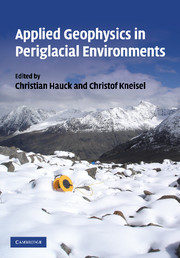Book contents
- Frontmatter
- Contents
- List of contributors
- Introduction
- Part I Geophysical methods
- Part II Case studies
- 5 Typology of vertical electrical soundings for permafrost/ground ice investigation in the forefields of small alpine glaciers
- 6 ERT imaging for frozen ground detection
- 7 Electrical resistivity values of frozen soil from VES and TEM field observations and laboratory experiments
- 8 Results of geophysical surveys on Kasprowy Wierch, the Tatra Mountains, Poland
- 9 Reassessment of DC resistivity in rock glaciers by comparing with P-wave velocity: a case study in the Swiss Alps
- 10 Quantifying the ice content in low-altitude scree slopes using geophysical methods
- 11 The use of GPR in determining talus thickness and talus structure
- 12 GPR soundings of rock glaciers on Svalbard
- 13 Arctic glaciers and ground-penetrating radar. Case study: Stagnation Glacier, Bylot Island, Canada
- 14 Mapping of subglacial topography using GPR for determining subglacial hydraulic conditions
- 15 Snow measurements using GPR: example from Amundsenisen, Svalbard
- 16 Mapping frazil ice conditions in rivers using ground penetrating radar
- Appendix: Tables of geophysical parameters for periglacial environments
- Index
- Plate section
- References
14 - Mapping of subglacial topography using GPR for determining subglacial hydraulic conditions
Published online by Cambridge University Press: 22 August 2009
- Frontmatter
- Contents
- List of contributors
- Introduction
- Part I Geophysical methods
- Part II Case studies
- 5 Typology of vertical electrical soundings for permafrost/ground ice investigation in the forefields of small alpine glaciers
- 6 ERT imaging for frozen ground detection
- 7 Electrical resistivity values of frozen soil from VES and TEM field observations and laboratory experiments
- 8 Results of geophysical surveys on Kasprowy Wierch, the Tatra Mountains, Poland
- 9 Reassessment of DC resistivity in rock glaciers by comparing with P-wave velocity: a case study in the Swiss Alps
- 10 Quantifying the ice content in low-altitude scree slopes using geophysical methods
- 11 The use of GPR in determining talus thickness and talus structure
- 12 GPR soundings of rock glaciers on Svalbard
- 13 Arctic glaciers and ground-penetrating radar. Case study: Stagnation Glacier, Bylot Island, Canada
- 14 Mapping of subglacial topography using GPR for determining subglacial hydraulic conditions
- 15 Snow measurements using GPR: example from Amundsenisen, Svalbard
- 16 Mapping frazil ice conditions in rivers using ground penetrating radar
- Appendix: Tables of geophysical parameters for periglacial environments
- Index
- Plate section
- References
Summary
Introduction
Recently initiated coal mining in Svea Nord, Svalbard, by Store Norsk Spitsbergen Kullkompani (SNSK), has encountered problems during summer seasons due to water intrusions that originate from the glacier above the mine (Melvold et al. 2003, Schuler et al. 2005). The coal mine Svea Nord is situated in bedrock 150–350 m below the bed of the Gruvefonna ice cap (Figures 14.1 and 14.2a). In Svalbard, ice-free land areas have continuous permafrost with thickness varying from less than 100 m near sea-level up to 500 m in the higher mountains (Liestøl 1977). However, beneath the accumulation areas of larger glaciers and ice caps, taliks (unfrozen areas within an otherwise frozen region) may exist (Liestøl 1977). Mining in permafrost regions, where it may encounter taliks, is a known challenge (Tolstikhin and Tolstikhin 1976), since, as in this case, a permeable talik enables the leakage of water into the mine. To stop the leakage from the usually continuous hydraulic system of the subpermafrost aquifer can be difficult, or even impossible. After removal of the coal, the roof of the mine is brought down to reduce the load on the remaining coal layer, thereby presumably increasing the permeability of the rock material between the glacier bed and the mine.
During summers 2003 and 2004, the water inflow in Svea Nord mine reached maximum rates of 2000 and 5000 m3h−1, respectively.
Information
- Type
- Chapter
- Information
- Applied Geophysics in Periglacial Environments , pp. 191 - 206Publisher: Cambridge University PressPrint publication year: 2008
References
Accessibility standard: Unknown
- 4
- Cited by
